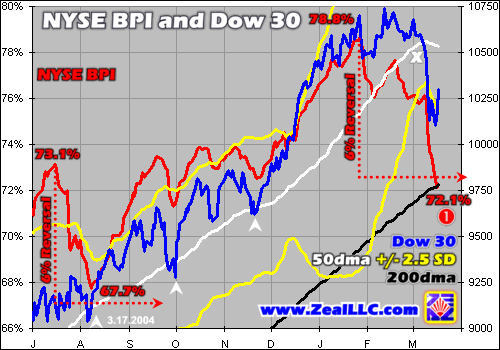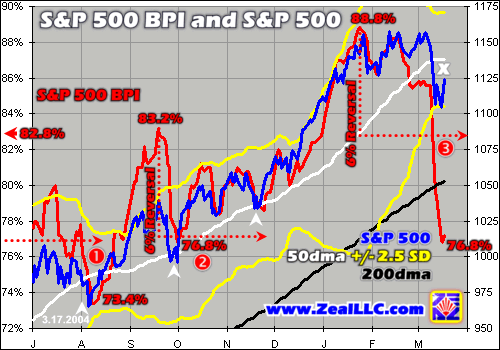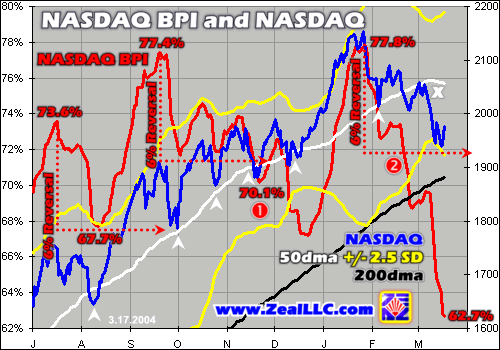|
|
|||||||
|
|
|
|
|
|
|
|
|
|
Trading the BPI Reversals 2 Adam Hamilton March 19, 2004 2839 Words
After powering relentlessly higher for the better part of a year, the US equity markets are showing increasing technical signs of internal decay and weakness with each passing week.
Index speculators are paying very close attention to these ongoing developments, as the markets are now poised on the razor’s edge between a normal healthy bull-market correction and a vicious renewed Great Bear downleg. It is too early to know for sure whether the bull or bear will win this particular battle, so all news from the front is carefully weighed by the players.
In just the past few days, a long-awaited technical sell signal has emerged in the famous Point-and-Figure Bullish Percent Indices, giving index speculators much to consider this week.
The flagship NYSE BPI index, for the first time since the war rally emerged last March, has finally carved a 6% reversal from its war-rally interim top! This development, unprecedented within the war rally, has been eagerly anticipated by the bears since last summer. This new NYSE BPI reversal joins the rapidly retreating S&P 500 and NASDAQ BPIs which have already reversed in recent weeks.
Thus, not only is the NYSE BPI carving its first war-rally-to-date 6% reversal, but for the first time in this rally all three of the major BPIs are simultaneously reversing! The NYSE, S&P 500, and NASDAQ BPIs are finally falling rapidly in unison, a concurrent-reversal situation that I had been discussing and looking for in my original “Trading the BPI Reversals” essay.
The Bullish Percent Indices reveal what percentage of the individual-company components in a given stock index are currently exhibiting point-and-figure buy signals on their price charts. They are very useful for identifying probable major trend changes early, before the headline levels of the stock indices themselves move far enough to clearly reveal an ongoing trend change.
In order for this cyclical bull in equities to revert back to bear mode, the supply of shares offered for sale has to exceed demand, forcing general stock prices lower. While such an imbalance will ultimately be reflected in the headline stock indices sooner or later, the early signs of increased selling pressure are first evident in the BPIs. Coming off of interim tops, such as January’s, plunging BPIs usually precede plunging stock prices.
One of the primary reasons that the BPIs provide early warning to speculators of an imminent trend change is due to the very nature of today’s market-capitalization-weighted indices like the NASDAQ. In a market-cap-weighted index, the largest companies dominate the headline index results each day. Strength in the leading market-darling companies like Microsoft and Intel can boost the NASDAQ and temporarily mask broader index-wide weakness.
But the BPIs equally weight every single component company in an index like the NASDAQ. If an increasing number of generic NASDAQ companies are fading in strength, the BPIs immediately reflect this as fewer and fewer companies are able to maintain P&F buy signals on their individual price charts.
In today’s market-cap-dominated stock world, the BPIs accurately gauge index-wide momentum and strength and are much more responsive to shifts in underlying stock supply and demand than the headline stock-index numbers. Unlike in the headline stock indices, in the BPIs a few large companies doing well cannot camouflage index-wide technical decay in the remaining multitude of companies.
The stunning magnitude of the recent weakness in the major BPIs is easiest to understand in graphical form. Our charts this week are updates from last month’s “Trading the BPI Reversals” if you would like more background information. Note that never before in this war rally have two of the major BPIs, let alone all three, concurrently reversed until this week!
Last summer the NYSE BPI almost reversed, but it couldn’t quite manage a full 6% reversal even though the stock markets were looking technically toppy at the time. As the markets started soaring in August the NYSE BPI charged higher and was soon carving fresh new rally-to-date highs, with no 6% reversals in sight. Until this week, a 6% NYSE BPI reversal had never been witnessed before during this war rally.
Since the latest NYSE BPI top of 78.8% in late January though, the accelerating decay in this flagship Bullish Percent Index has been relentless. Even though the Dow 30 managed to carve a new interim high in February about two weeks after the NYSE BPI topped, the BPI itself could not even rally back up to its recent high, let alone assault fresh new territory.
While the general US stock markets showed impressive strength in their headline numbers by achieving new closing highs in February, the fading BPIs were betraying increasing internal technical decay. The leading early warning signals of changing internal technicals inherent in the BPIs were becoming increasingly apparent as the BPIs diverged from the headline stock indices.
It is easiest to see this divergence if you first examine the interaction of the Dow 30 and NYSE BPI between September and November of last year. During that time frame, the stock indices gradually marched higher while the BPIs generally moved in lockstep with them. Every new interim high in the Dow 30 last autumn was accompanied by another new interim high in the NYSE BPI. The whole broad NYSE was advancing.
There were some sharp pullbacks last fall, such as the one at the end of September, that dragged the BPI down with them. Yet, each time the NYSE BPI fell, it quickly recovered as soon as the stock markets did and it was soon clawing its way back up to new rally-to-date highs. The NYSE BPI was in an uptrend just like the stock indices, suggesting that the technical internals of the war rally remained relatively sound back then.
Contrast last autumn’s BPI interaction with the markets of today. The early February rally in stocks managed to push the indices to new highs, but the BPI couldn’t keep up. Broad market strength was waning and capital was increasingly concentrating in big-name market darlings, not a healthy sign. There was another spike up in the Dow 30 at the end of February, but the NYSE BPI hardly even reacted. After a minor little blip up, it continued falling.
In the second week in March, the stock indices corrected hard. The BPIs did not take this well though, and started plunging off of a cliff. While not so apparent in the slow-to-move NYSE BPI above, the next couple charts of the S&P 500 and NASDAQ BPIs really highlight the sharp and vicious slide in the BPIs in general in the last couple weeks. It has been extraordinary.
Thus, for the past month or so, the BPIs have only been marginally up when the stock indices are higher, but when the stock indices start falling the BPIs have just plunged. A clear bearish bias is emerging in the BPIs as the internal strength of the war-rally cyclical bull fails. Fewer and fewer index-component companies are able to maintain P&F buy signals on their price charts as broad selling intensifies.
While the NYSE BPI’s weakness did indeed lead the Dow 30’s correction, we don’t want to overlook some extremely interesting technical developments in the stock index itself. In the chart above, carefully examine the past couple weeks of Dow 30 action.
For the first time since the war rally launched, the mighty blue chips have broken decisively below their key 50dma support line. This sharp break with precedent alone shows speculators that something is very different in this current correction as compared to previous rally-to-date pullbacks which all bounced like clockwork just below the Dow 30’s key 50dma.
Once a 50dma fails, we would expect to find the next support zone near the lower Bollinger Band, drawn in yellow above. This represents a price that is two-and-a-half standard deviations below the 50dma of the Dow 30, a statistically low-probability price event that often marks a short-term turning point. And right on cue the Dow 30 is bouncing around near this lower Bollinger Band today. Even if this current correction continues, it will probably slow down a bit now until the Bollinger Band envelope catches up with it.
At this point, with the Dow 30 at its lower Bollinger Band, there is really no reason for the bulls to be frightened yet. Pullbacks and corrections in a bull market are healthy and expected, and we have been overdue for one for quite some time. Until the Dow 30 falls all the way back down to its 200dma, currently near 9780, the bulls can still rightfully claim that this is a correction and the cyclical bull-market uptrend remains intact.
But if the Dow 30 and the rest of the US stock indices fall farther to challenge their 200dmas, the bulls are going to grow very nervous. As I have discussed in great depth relative to the ongoing gold bull, there is no more important long-term support in any bull market than its 200-day moving average. The 200dma marks the razor’s edge between bull and bear markets. As long as the major US indices remain above their 200dmas, the war-rally bull will still be technically intact.
But if this 200dma line in the sand is crossed, if the major US stock indices fall decisively below their 200dmas, then the whole bullish thesis is thrown on its ear. Astute speculators in both the bull and bear camps will recognize the magnitude of a 200dma failure and trade accordingly, with the bulls liquidating longs and the bears adding shorts. If the 200dma doesn’t hold as support, the war rally is probably finito.
Now if only the Dow 30 was correcting, or only the NASDAQ, today’s markets wouldn’t be so intriguing. But, as you will see below, all of the major BPIs are simultaneously plunging to unprecedented reversal levels within the war rally. And all of the stock indices themselves are concurrently bouncing along their lower Bollinger Bands in a middle technical zone between their 50dmas and 200dmas. Is a major trend change afoot?
Unlike the NYSE BPI, the SPX BPI is now in its third 6% reversal since the war rally began. As outlined in prior essays on these reversals, it is important to realize that these, just like any other technical tool, are certainly not foolproof. I am hoping that we can minimize trading on these false signals of trend changes by looking for concurrent BPI reversals across multiple major BPIs, an event that is only probable during a serious correction or major trend change.
Just as we noticed in the NYSE BPI above, this current S&P 500 BPI behavior is vastly different than anything witnessed before in the war rally. Last autumn you will note that the SPX BPI closely tracked the actual S&P 500 stock index. The BPI pulled back when the S&P 500 did, but as the stock index sprang back to life after each minor pullback its BPI quickly clawed up to new ascending interim highs. The headline S&P 500 number was truly reflecting its internal technical strength at the time.
In the past month though, even as the S&P 500 challenged its recent interim high its BPI refused to play along with the headline rally. The mighty index’s internal technicals were fading as selling pressure increased in S&P 500 component companies. As soon as the S&P 500 finally broke below its key 50dma and plunged towards its lower Bollinger Band support, its BPI plummeted like a millstone.
The recent SPX BPI plunge is really quite extraordinary. It has reversed by 12% from its interim high of January, with three-quarters of this reversal in just the last week or two. As I eagerly watch this BPI index each trading day, it was fascinating to see it continue to plunge in recent days even while the headline S&P 500 bounced higher along its lower Bollinger Band. Internal technical decay was rampant even while the headline index tried to reconnoiter along its interim support.
Although this is the third time that the SPX BPI has fallen by 6% or more from its latest interim top, the character of today’s decline is vastly different. For some reason, the internal point-and-figure-buy-signal positive breadth in this all-important stock index is failing big time. A bull market cannot charge higher on market-darling buying alone, but broad strength is necessary.
Just like the Dow 30 above though, until the S&P 500 falls decisively below its 200dma currently near 1050 it is still technically in a cyclical bull market. A break below its 50dma can be a normal healthy correction as long as its 200dma holds. If this correction continues and the 200dma is challenged though, the bulls will be sweating bullets and the bears will be licking their chops with glee.
The NASDAQ BPI is also concurrently reversing at breakneck speeds, currently down an incredible 15% from its latest interim high of January! The NASDAQ stock-index technicals alone are also deep into correction mode. All of the Big Three US stock indices are in agreement that today’s market weakness is unprecedented within the context of this war rally.
We are now deep into the second 6%+ reversal in the NASDAQ BPI of the war rally so far, but as this graph clearly shows the magnitude of this reversal easily dwarfs everything that came before it. Just like the NYSE and S&P 500, the NASDAQ’s internal strength is rapidly fading as more and more of its component stocks lose their ability to maintain bullish point-and-figure buy signals.
As the NASDAQ BPI plummets, the NASDAQ itself has broken decisively below its 50dma for the first time in the war rally and is now attempting to regroup at its lower Bollinger Band. This leading speculative index is also getting closer to its crucial line-in-the-sand 200dma now near 1880. If the NASDAQ’s 200dma fails, it is going to scare the heck out of a lot of tech speculators and bring in a massive wave of new shorts.
While the first NYSE BPI 6% reversal is the most notable development in BPI-land this week, the rapidly plummeting NASDAQ BPI may really be the most important. As I discussed last week in “War Rally Failing”, the war rally was led higher by technology speculation. If many of the technology speculators are jumping ship now, as the NASDAQ BPI seems to indicate, then how is the war rally going to continue higher without its leadership?
With all three of the elite US stock indices scraping along their lower Bollinger Bands within striking distance of their do-or-die 200dma cyclical-bull support lines, speculators really need to carefully monitor the equity scene today. We are really on the very razor’s edge between a continuing bull-market uptrend or a resurgent Great Bear downtrend.
If the markets are able to bounce higher off of their Bollinger Bands today or off of their 200dmas in the near future, then the bulls can rejoice as their bull market remains technically intact. But if the 200dmas fail as support, then every technical analyst from here to Timbuktu is going to get really excited. There will be tremendous pressure on the bulls to sell positions to lessen their exposure to a looming hazard, and the bears will have a huge incentive to aggressively short sell again in anticipation of a new bear downleg.
This selling pressure is already growing according to the Bullish Percent Indices. At this point in time they are falling rapidly across the board and are unable to recover when their respective stock indices bounce at support. A healthy bull market is marked by strong broad participation in the uptrend, not merely limited buying in a few major big-cap darlings that can temporarily levitate the stock indices.
While as mere mortals we cannot know the future like God, we are monitoring this situation very closely at Zeal. We have index-options speculation plans and strategies in place to capitalize on an accelerating downleg if it continues developing. We have also laid plans to protect ourselves if this correction manages to bounce at the index 200dmas and the cyclical stock bull continues marching higher towards the election. Either way, the volatility should be quite tradable.
I continue to discuss these strategies and recommend specific index-options trades as appropriate in both our Zeal Intelligence monthly newsletter and Zeal Speculator alert service for our subscribers. Please consider joining us today if you would like to game the great opportunities approaching in the stock indices.
However this all plays out, the first NYSE BPI 6% reversal coupled with the first simultaneous 6%+ reversals in the NYSE, S&P 500, and NASDAQ BPIs are very notable technical events unprecedented within the war rally. Internal technical decay in the major US stock indices is accelerating, which certainly could bode a major trend change lying ahead.
Whether today’s stock weakness will burn itself out at a bull-market correction or feed on itself into a Great Bear downleg I know not, but however it plays out I am excited to see the equity markets finally getting interesting once again.
Adam Hamilton, CPA March 19, 2004 Subscribe |
|||||||
|
|
|
|
|
|
|
|
|
|
|
|
|
|
|
|||



